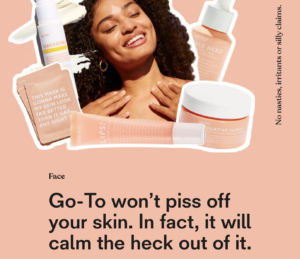My other shortlisted headline for this post was ‘how to nail conversational copywriting’.
Because (spoiler alert) writing copy that creates a connection is all about sounding like you’re having a good ol’ chat with your reader.
But it’s often drilled into us that to show our intelligence we should use a formal tone, perfect grammar, complex language and fancy pants long words.
But I agree with the copywriter, Nick Usborne:
“If you believe in your product or service, and if you respect and like your audience, your marketing should feel like a conversation.”
Amen, sir.
So here’s how to ditch the boring ‘corporate speak’ and write human-sounding copy that keeps your readers hangin’ on your every word.
1. Write to one person
Ever heard the phrase, ‘if you try to please everyone, you’ll end up pleasing no-one’?
Well, that applies perfectly to copywriting.
Yes, you may well be writing a post for your 500 Instagram followers or a newsletter to your 1,000 email subscribers but the trick is to ignore the masses.
And imagine you’re writing to just one person.
That person could be your ideal customer or your best friend.
It’s someone you know very well. You know how they speak. You know their pain points and you know how to have a chat with them.
This mindset helps you find your voice, get clear on your message and build that special one-to-one connection with your reader.
2. Find your conversational voice
Imagine you’re having a personal conversation with your BFF or ideal customer.
What tone would you use? What sort of words would you say?
Using simple and personal language is the art of conversational copywriting.
Ditch the big, complex words and the jargon.
Tip: I keep a ‘word bank’ (aka a list) of words and phrases that I say when I speak. I then inject some of these into my writing to make it sound more human.
Go-To skincare is a great example of a brand who successfully uses a very informal, human tone of voice in their marketing content.

3. Be helpful not ‘salesy’
Write to help your audience, not sell to them.
Think about the words and phrases your reader uses to describe their problem. Use their words, not yours, so they can easily understand and relate to you and how you can help them.
Again, keep your messaging personal and simple.
4. Use the superpower of ‘you’
‘You’ is one of the most powerful words you can use in your content.
By using less ‘I’, ‘me’ and ‘we’ and including more ‘you’ and ‘your’, you’ll write content that connects and engages directly with your reader.
Go back to that conversation you’re having with your best friend. Do you speak about yourself all the time or is it a two-way chat?
5. Show your personality
Engage and hold the attention of your reader by showing your personality. Don’t be afraid to show them who you really are.
Share your stories, share your mistakes and share personal anecdotes – just like you would in a conversation. Keep your reader interested.
A perfect example is Balter Beer’s About page:

And there lies the start of a story you want to sit and listen to over a (Balter) beer!
6. Break some rules
Confession: I’m a rule breaker when it comes to grammar.
Example? I often start my sentences with conjunctions (and, but, so, because).
Because (haha) I’ll do anything to keep my reader engaged in the conversation. It’s more dynamic. It prevents monotony and it tells the reader that you’ve more to say.
So, I’ll keep on doing it.
7. Ask questions
If you were having a chat with your best friend would you ask them questions?
Yeah, I think you would. And it’s no different when you’re writing to them.
Because asking your reader a question is a great way to keep them on their toes and it encourages them to stop and think about what you’re writing.
8. Be less ‘wordy’
Make your writing easy to read by using short sentences and paragraphs.
Another good trick is to use contractions to make your writing less formal. Replace ‘you are’ with ‘you’re’, ‘we are’ with ‘we’re’ and ‘are not’ with ‘aren’t’ etc.
Short and sweet is the name of the game.
Finally, when you’ve written your blog, social media post, or email read it out loud to yourself.
Does it flow? Does it sound natural? Do you think your best friend or your ideal customer would find it interesting?
If it’s a yes, a yes and a ‘hell yeah’ then you’re good to go.
I love this latest blog, Jennie! It’s got loads of great tips with good specific examples that we can use for Wine Country Chocolates. By the way, that’s a beautiful font. What’s it called? Thanks.
So glad you found it useful Betty! The font that I use in the body copy is Montserrat.